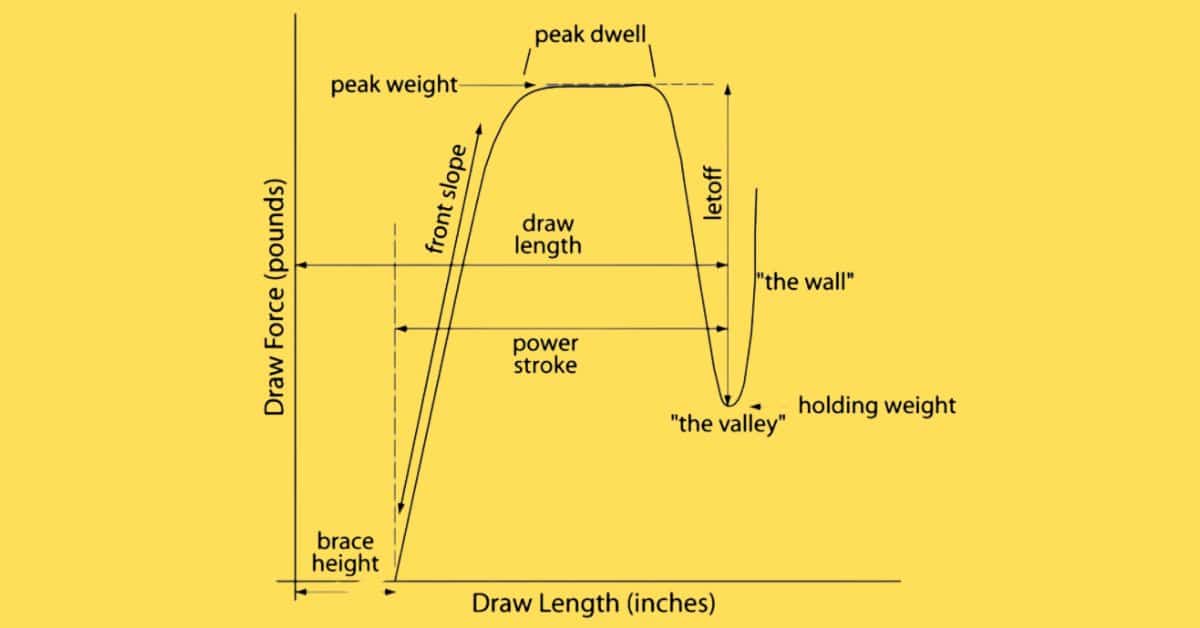In compound bows, “let-off” refers to the percentage of the peak draw weight that reduces at full draw due to the cams and cables. A 60-pound draw weight with 80% let-off means holding back about 12 lbs at full draw. Higher let-off eases holding at full draw for hunters, while lower let-off suits target archers managing bow weight. Preferences vary based on shooting style, purpose, and strength.
From this article, you will get to know what is let off in a compound bow and more.
What Is Let Off In A Compound Bow & How Does It Work?
An archer must hold back a certain amount of force at full draw to reduce the draw weight when the compound bow is fully drawn. Let off in compound bows is a critical factor because it affects the ease of aiming and holding the bow steady. Let-off is expressed as a percentage and represents the amount of force the archer needs to hold back at full draw.

When you draw a compound bow, the cams or wheels at the ends of the limbs rotate, which allows the bow to reach its peak draw weight. At a certain point during the draw, the cams reach their maximum rotation, and this is when the let off takes effect. The design of the cams allows the draw weight to decrease significantly. This makes it easier for the archer to hold the bow in a fully drawn position.
For example, if a compound bow has a 60-pound draw weight with 80% let off when the bow is fully drawn, the archer would only need to hold back roughly 12 pounds (20% of the original draw weight). This means 80% of the bow’s draw weight is “let off” at full draw. This remarkable engineering feat not only redefines the archery experience but also opens doors for archers to explore new heights of accuracy and precision.
You must keep in mind that the amount of let off in a compound bow can vary. Also, different archers prefer different let offs based on their shooting style and purpose.
To put this into perspective, hunters often prefer higher let off, usually in the 80-85% range. That’s because it allows them to hold the bow at full draw for longer periods without fatigue.
On the other hand, target archers may opt for lower let off, typically around 65-70%. Its purpose is to provide more holding weight. During precision shots, this can help maintain stability.
However, the journey from full draw initiation to the release of the arrow is far from a linear progression. The compound bow’s mechanics, notably the unique cam system, introduces an element of complexity to the draw cycle. Characteristically shaped in a manner reminiscent of an eccentric pulley system, the cams guide the bowstring through distinct phases of tension as it is drawn.
As an archer draws the bowstring, the effort required increases progressively, reflecting the elliptical shape of the cams. This phase of accumulating tension culminates in what is known as the “valley.” The valley marks the point in the draw cycle where the archer arrives at full draw; the bowstring is drawn taut, and the potential energy is at its zenith.
Yet, this is not the end of the story. The valley introduces an intriguing twist; it manifests as a deceptive ease, a temporary lull before the storm. During this momentary respite, the archer experiences a relatively lighter tension in the bowstring. This interlude creates an opportunity for the archer to steady their aim and fine-tune their shot. However, lurking beyond this serene interval is the enigma that gives the valley its name.

Sudden and often seemingly paradoxical, the valley transforms from a sanctuary of calm into a realm of daunting difficulty. At this juncture, the bow’s resistance surges, requiring the archer to exert significant effort to maintain the full draw position. This sharp increase in tension serves as a safeguard against accidental releases and ensures stability during aiming. It’s a paradox within the design—a moment of heightened tension within the very “comfort zone” of the draw cycle.
In essence, the compound bow’s let-off and valley embody the epitome of ingenuity. The let-off facilitates the task of drawing heavy draw weights, while the valley provides a brief reprieve before testing the archer’s mettle. This combination not only delivers unparalleled shooting accuracy but also enriches the archery experience by presenting an intricate dance of mechanics and physics.
Calculating and Measuring Let-Off
To calculate the let-off in archery, you can use the following formula:
Let-Off Percentage = (Initial Draw Weight – Holding Draw Weight) / Initial Draw Weight * 100
Initial Draw Weight: The maximum force required to pull the bowstring to its full draw length.
Holding Draw Weight: The reduced force required to keep the bowstring at full draw due to the let-off.
For example, if a compound bow has an initial draw weight of 70 pounds and a holding draw weight of 20 pounds, the let-off percentage would be:
Let-Off Percentage = (70 – 20) / 70 * 100 = 71.43%
This means that at full draw, the archer is only holding back 28.57% of the initial draw weight.
Keep in mind that these explanations and calculations are based on general concepts, and actual measurements may vary based on equipment and specific conditions.
Benefits of Having Proper Let Off In Your Bow:
Let-off isn’t just a fancy term; it has practical benefits. When you reach full draw, the reduced holding pressure lets you focus more on your aim. Your accuracy and steadiness get a boost, making those bullseyes more achievable. Additionally, you can keep your aim steady for longer, crucial for nailing those precise shots. And guess what? Less holding pressure means less fatigue and muscle strain, a win-win for your shooting comfort.
Why More is Not Good In Compound Bow Let Off Scenario?
Naturally, the desire for greater advantages leads to the notion that more let-off is better. However, this is not necessarily the case, especially for target archers. While a bow with near 100% let-off might seem appealing due to the minimal strain experienced at full draw, it can lead to issues during arrow launch. A very low holding weight, or high let-off, implies that even a small force can alter the launch position of the arrow’s rear end, making it easier to mislaunch arrows. This struggle is akin to recurve archers who lack sufficient draw force to cleanly release the string.
Many compound target archers gravitate towards around 65% let-off. This percentage provides a balance between reduced strain and enough holding weight for a clean arrow launch. It’s worth noting that exact let-off cannot be rigidly established in a bow, as adjustments in draw weight, brace height, and other factors can slightly affect let-off.
Hunters, on the other hand, tend to prefer bows with 80% let-off. This choice is influenced by the practicalities of hunting scenarios, where shots might be few, taken from awkward positions, at larger targets, or on moving game. The increased let-off affords hunters more time at full draw, which is a key benefit. With less strain during this phase, archers have the luxury to align their bows meticulously and aim precisely. This contrasts with traditional bows like recurves and longbows, where the peak weight persists at full draw, leaving less time for careful alignment and aiming.
What Is The Best Let Off For A Bow?
For target archers, the best let off ranges from 60% to 70%. For hunters, the best let off may lean towards around 80%. So, the best let off for a bow depends on the archer’s shooting style, purpose, and personal preferences. Most of the modern compound bow for less than 500 dollars offers 70 to 80% let off features which are more than enough for hunters.
In order to achieve a clean and stable release of the arrow, target archers need a smaller let off percentage at full draw. It is better to have some holding weight on the arrow’s rear end, which prevents it from being disturbed during release.
Hunters, however, need a higher let off as they may need to wait for the right time to take a shot. The extra time at full draw is beneficial when hunters must remain still and aligned for a longer period of time.
So, you should set your compound bow let off based on your preference and purpose.
How To Adjust Let Off In A Compound Bow?
Adjusting the let off in a compound bow typically involves changing the module or cam settings. Keep in mind that, different bows have different mechanisms for adjusting let off.
Here is a generalized process to adjust the let off in a compound bow:
- Identify the draw length module which is usually a small metal or plastic piece that determines the bow’s draw length. It is attached to the cam or module system on the bow.
- There are typically two screws holding the draw length module in place. Loosen these screws, but do not remove them completely.
- Once the screws are loose, rotate the module to the desired position. Lower numbers on the module setting will result in a longer draw length and higher let off. On the contrary, higher numbers will shorten the draw length and reduce the let off.
- After adjusting the module, tighten the screws back securely to hold the module in its new position.
In some compound bows, they feature the draw stop to adjust the let off. In that case, set the draw stop according to the chosen module setting to achieve the desired let off percentage.
Let Off vs. Traditional Bows: Head-to-Head Comparison
Accuracy and Precision
Let off bows excel in accuracy due to reduced holding weight, allowing archers to maintain steadier aim. Traditional bows require more physical effort to hold at full draw, potentially affecting accuracy during prolonged aiming.
Power and Speed
Traditional bows can generate significant power and speed due to their design and lack of let off mechanisms. Let off bows, while accurate, may sacrifice some power in exchange for reduced holding weight.
Maintenance and Durability
Let off bows often require more maintenance due to their complex mechanisms, while traditional bows are simpler in design and may have fewer parts prone to wear and tear.
What Are The Pros And Cons Of Let Off Compound Bow?
Using let off in compound bows has revolutionized archery. However, it is not without its drawbacks. Let’s check out the pros and cons off let off.
Pros of Let Off
- Reduced Holding Weight: Let off allows archers to hold significantly less weight at full draw, making it easier to maintain a steady aim and shoot more accurately. This reduces fatigue and provides more time to focus on aiming and form.
- Less General Fatigue: With reduced holding weight, archers experience less overall fatigue during shooting sessions, enabling them to shoot more arrows and maintain better accuracy over time.
- Easier Learning and Practice: Compound bows with let off are more beginner-friendly, as they require less physical strength to handle at full draw. This makes them ideal for new archers who want to focus on learning proper form and technique.
Cons of Let Off
- In bows with very high let off, the reduced effort required to hold the bow at full draw can lead to bow arm fatigue. This can negatively affect the accuracy and shooting duration, especially for professional archers using heavy setups.
- Bad Form Risk: High let off can encourage archers to rely too much on the mechanical advantage, leading to improper form and a lack of follow-through. This can be detrimental to accuracy and overall shooting performance.
- Limited Transfer to Traditional Bows: Archers who primarily shoot compound bows with high let off may find it challenging to transition to traditional bows or recurve bows, which lack let off. Shooting with traditional bows requires more sustained effort and can be physically demanding if not accustomed to it.
Let Off Bow Shooting Tips
- Focus on Form: Proper form is essential for accuracy with a let off bow. Pay attention to your stance, grip, and anchor points.
- Utilize a Release Aid: Using a release aid can enhance your consistency and reduce finger fatigue.
- Regular Practice: Regular practice sessions will help you become familiar with the bow’s let off and improve your overall shooting technique.
Common Misconceptions: Debunking Let Off Myths
Despite its widespread recognition, let off remains the subject of various misconceptions. Some mistakenly believe that let off equates to an easier shot, diminishing the skill required. In truth, while let off eases muscle strain, achieving accurate shots still demands skillful execution and consistent practice.
Conclusion
So, as a beginner archer, understanding what is let off in a compound bow is crucial. You can use this to improve your accuracy and technique as an archer. Also, you can develop counters to its drawbacks.
In a nutshell, let-off is the secret ingredient that turns compound bows into precision instruments. Remember, finding the right let-off percentage tailored to your needs can elevate your archery game. So, the next time you’re choosing a compound bow, don’t forget to factor in let-off – your accuracy, comfort, and overall shooting experience will thank you for it. And always remember, practice makes perfect.

About The Author:
Lake Streeter, A Gun enthusiast, and loves to hunt in the middle of the wood. Always check the latest hunting gears out in the market and try to share his honest opinion with the audience in Hunting Nook.
